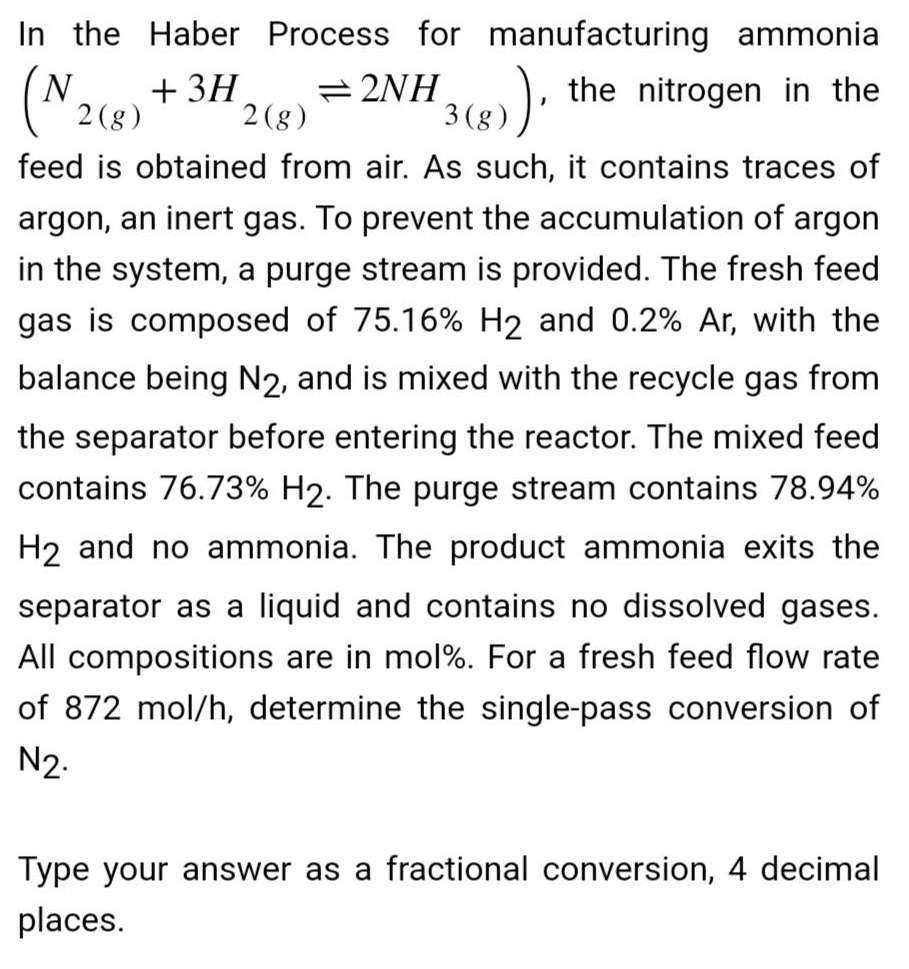In the Haber Process for manufacturing ammonia +3H ≥2NH3(g))' the nitrogen in the (N ₂0 2(g) 2(g) feed is obtained from air. As such, it contains traces of argon, an inert gas. To prevent the accumulation of argon in the system, a purge stream is provided. The fresh feed gas is composed of 75.16% H2 and 0.2% Ar, with the balance being N2, and is mixed with the recycle gas from the separator before entering the reactor. The mixed feed contains 76.73% H₂. The purge stream contains 78.94% H2 and no ammonia. The product ammonia exits the separator as a liquid and contains no dissolved gases. All compositions are in mol %. For a fresh feed flow rate of 872 mol/h, determine the single-pass conversion of N₂. Type your answer as a fractional conversion, 4 decimal places.
In the Haber Process for manufacturing ammonia +3H ≥2NH3(g))' the nitrogen in the (N ₂0 2(g) 2(g) feed is obtained from air. As such, it contains traces of argon, an inert gas. To prevent the accumulation of argon in the system, a purge stream is provided. The fresh feed gas is composed of 75.16% H2 and 0.2% Ar, with the balance being N2, and is mixed with the recycle gas from the separator before entering the reactor. The mixed feed contains 76.73% H₂. The purge stream contains 78.94% H2 and no ammonia. The product ammonia exits the separator as a liquid and contains no dissolved gases. All compositions are in mol %. For a fresh feed flow rate of 872 mol/h, determine the single-pass conversion of N₂. Type your answer as a fractional conversion, 4 decimal places.
Introduction to Chemical Engineering Thermodynamics
8th Edition
ISBN:9781259696527
Author:J.M. Smith Termodinamica en ingenieria quimica, Hendrick C Van Ness, Michael Abbott, Mark Swihart
Publisher:J.M. Smith Termodinamica en ingenieria quimica, Hendrick C Van Ness, Michael Abbott, Mark Swihart
Chapter1: Introduction
Section: Chapter Questions
Problem 1.1P
Related questions
Question

Transcribed Image Text:In the Haber Process for manufacturing ammonia
(N2(g) + 3H
= 2NH
3(g)), the nitrogen in the
feed is obtained from air. As such, it contains traces of
argon, an inert gas. To prevent the accumulation of argon
in the system, a purge stream is provided. The fresh feed
gas is composed of 75.16% H2 and 0.2% Ar, with the
balance being N2, and is mixed with the recycle gas from
the separator before entering the reactor. The mixed feed
contains 76.73% H2. The purge stream contains 78.94%
H2 and no ammonia. The product ammonia exits the
separator as a liquid and contains no dissolved gases.
All compositions are in mol%. For a fresh feed flow rate
of 872 mol/h, determine the single-pass conversion of
N₂.
2(g)
Type your answer as a fractional conversion, 4 decimal
places.
Expert Solution
This question has been solved!
Explore an expertly crafted, step-by-step solution for a thorough understanding of key concepts.
This is a popular solution!
Trending now
This is a popular solution!
Step by step
Solved in 4 steps with 1 images

Recommended textbooks for you

Introduction to Chemical Engineering Thermodynami…
Chemical Engineering
ISBN:
9781259696527
Author:
J.M. Smith Termodinamica en ingenieria quimica, Hendrick C Van Ness, Michael Abbott, Mark Swihart
Publisher:
McGraw-Hill Education

Elementary Principles of Chemical Processes, Bind…
Chemical Engineering
ISBN:
9781118431221
Author:
Richard M. Felder, Ronald W. Rousseau, Lisa G. Bullard
Publisher:
WILEY

Elements of Chemical Reaction Engineering (5th Ed…
Chemical Engineering
ISBN:
9780133887518
Author:
H. Scott Fogler
Publisher:
Prentice Hall

Introduction to Chemical Engineering Thermodynami…
Chemical Engineering
ISBN:
9781259696527
Author:
J.M. Smith Termodinamica en ingenieria quimica, Hendrick C Van Ness, Michael Abbott, Mark Swihart
Publisher:
McGraw-Hill Education

Elementary Principles of Chemical Processes, Bind…
Chemical Engineering
ISBN:
9781118431221
Author:
Richard M. Felder, Ronald W. Rousseau, Lisa G. Bullard
Publisher:
WILEY

Elements of Chemical Reaction Engineering (5th Ed…
Chemical Engineering
ISBN:
9780133887518
Author:
H. Scott Fogler
Publisher:
Prentice Hall


Industrial Plastics: Theory and Applications
Chemical Engineering
ISBN:
9781285061238
Author:
Lokensgard, Erik
Publisher:
Delmar Cengage Learning

Unit Operations of Chemical Engineering
Chemical Engineering
ISBN:
9780072848236
Author:
Warren McCabe, Julian C. Smith, Peter Harriott
Publisher:
McGraw-Hill Companies, The